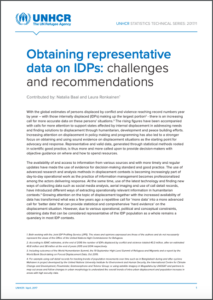UNHCR Technical Series: Guest Article on Obtaining Representative Data on IDPs (2016)
 What is needed for IDP data to be representative? And how representative does it really need to be or are there other significant factors that make the data useful?
What is needed for IDP data to be representative? And how representative does it really need to be or are there other significant factors that make the data useful?
Finding answers to these questions remains a quandary in many IDP contexts, due to various operational, political and conceptual constraints. In a brief article, published with the launch of the new UNHCR Statistics Technical Series*, we discuss key technical conditions to obtaining representative data on IDP populations.
We also look into the main challenges that often stand in the way of achieving ‘representative IDP data’, that is data that reflects the true characteristics in the total IDP population that is of concern. We aim to provide food for thought and to encourage through a number of recommendations ways to reconsider the types of data and processes currently in use.
The reflections exposed in this article build on an earlier publication drafted collaboratively by three previous JIPS Coordinators: Forced Displacement, Go Figure: Shaking the Box of Profiling IDP Situations, which contains lessons based on over seven years of operational experience supporting profiling exercises in displacement contexts globally. The article also presents a case study from Somalia to demonstrate arguments put forward by the authors.
——
*The UNHCR Statistics Technical Series is being launched in the context of the revision of their Statistical Yearbook.